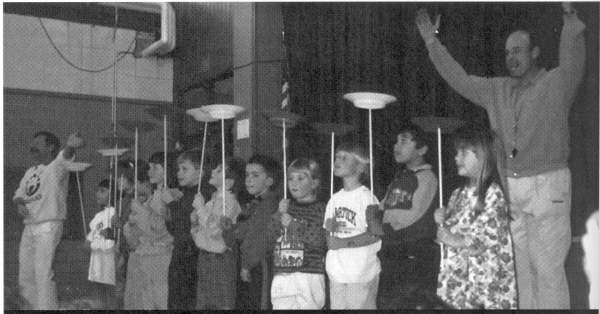
Finnigan (far end) and a happy teacher present their kindergarten-level plate spinners to the rest of the school. |
Page 18 Summer, 1994
|
Professor
Confidence Promotes Future of School Programs in Classroom BY
BILL GIDUZ, EDITOR
After
spending the last 18 years promoting juggling instruction in school
Budgetary
pressure that is forcing school systems to cut physical education
programs makes a classroom-based program of juggling instruction
both more marketable and more attractive to schools, says the man
who countless learners know as "Professor Confidence."
A
veteran of two decades of school programs, the founder of Jugglebug
equipment manufacturing and The Juggling Institute thinks he's found
a better way to teach juggling to young people. For the past year
Finnigan has driven a recreational vehicle from coast to coast with
his family to promote his "Juggling With Success" program
in 40 states. He is hosting a workshop at the IJA's Burlington
Festival to share his ideas with others who may be interested in the
approach. Then it's back into the RV for another year of overnights
in elementary school parking lots in hopes of establishing a
demonstration project in every state.
Finnigan
said, "From a juggler's point of view it's ideal. You don't
have to be a really good juggler and you don't need a partner.
People can do this program by themselves, and can let students be
the whole show at the end of the day. The juggler can just emcee
from backstage and never juggle at all."
That's
because, from the instructor's point of view, "Juggling for
Success" emphasizes "look at you" rather than
"look at me." Finnigan explained, "I think this is
the next wave in instruction. If we ever want to make juggling
part-and-parcel of learning in the schools this is the best hope. I
don't think there is any 'true way' to do it, but this has more
long-term potential for the popularization of juggling than
promoting it as a hippy street art form. There's room for both, but
if you do want to see juggling taught widely in schools, then this
is the way to do it."
In
about 60 schools last year, and up to 130 in the coming year,
Finnigan produced his all-day show. Waking up in their recreational
vehicle in the school parking
During
the next 30 minutes Finnigan told teachers what he hoped to
accomplish, and gave them a six-minute scarf juggling lesson. He
also asked them to remain with their students during their lesson
rather than running off for a cup of coffee. Then he met with grade
levels one at a time, concentrating on upper grades, working with up
to 100 students at a time for at least an hour. Each grade level
works on a different skill. Five-year-old Benjamin often taught
kindergarten students by himself to balance peacock feathers. First
graders learned spinning plates. Second graders did "criss-cross
applesauce" with two scarves. Third graders did scarf juggling,
and fourth, fifth and sixth graders worked with beanbags and rings.
Finnigan
During
the final five minutes of each period Finnigan talked about their
part in the end-of-school. show. Then during the last period of the
day, all students and teachers filed into the gym for their moment
in the
For
the finale, Finnigan invited all teachers to come juggle on stage.
"I always talked about how the teachers are life-long learners,
and they have all learned to juggle today. The kids love it, and
give the teachers a big cheer, which the teachers love."
In
the ideal juggling world, that daylong program becomes the kickoff
for a continuing classroom-based activity. The school buys copies of
the "Juggle time" scarf video for first through third
graders, while fourth through sixth graders learn from the
"Juggling Star" beanbag and ball video and "Juggling
Step-by-Step," which Finnigan describes as a video version of
his instruction book "The Complete Juggler." Each class
also needs enough equipment in the classroom for all students.
"We've
created a program that works at the classroom level," said
Finnigan. "Where juggling used to be something phys ed teachers
would do to round out a games unit, regular classroom teachers can
now motivate and physically educate students every day." |

Finnigan (far end) and a happy teacher present their kindergarten-level plate spinners to the rest of the school. |